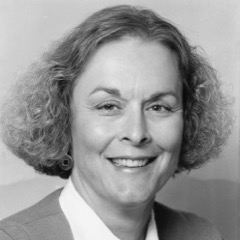1992 to 1993 – National Association of Collegiate Women Athletic Administrators
It didn’t take long for NACWAA’s rebranding to pay off. In the words of President Marcia Saneholtz, “I believe the new look reflected the renewed energy, enthusiasm and commitment growing among our members”(NACWAA Newsletter 10.2). The organization saw rapid growth in numbers, resources, and recognition in the years following the name change.
“I am convinced the climate of change, which has been set in motion, is irreversible. Gender discrimination in intercollegiate athletics will end, and when it does the intercollegiate athletic experience will be more profound for all of our student-athletes, male and female” (Vol. 10.2).
In order to keep up with the growth of the organization, the need for sponsorships, grants, and partnerships became Marcia’s top priority.
“[We need to] position the organization financially so we can afford an executive director to provide continuity of leadership; encompass more groups under our umbrella; and provide mentors for new professionals” (Vol 10.2).
NACWAA signed 13 sponsorships for its 1993 Fall Forum, totaling over $13,300. Major sponsors included the Sara Lee Corporation, Sports Coverage Inc., and the National Association of Gymnastics Coaches for Women (NAGCW).
Following a decade of minimal growth for women in athletics, 1993 saw a record-high 600 members, a national presence bigger than ever before, and a “new energy” to propel women in athletics through the 90’s.
“The often heard ‘there aren’t many qualified women out there’ is the farthest thing from the truth. There are hundreds of us–working hard every day to make a difference for all student-athletes. We are tremendous assets. Too often we take ourselves for granted, and so do others. We’re more than just competent, we’re darn good! Let’s do a better job of promoting each other” (NACWAA Newsletter 11.1).
Other major accomplishments from NACWAA during this time frame (NACWAA Newsletter 10.3, NACWAA Newsletter 10.4):
- NACWAA announced its first paid internship, located at the site of the president’s institution; intern compensation was evenly split between NACWAA and the president’s university
- Marcia and the Board of Directors encouraged all members to attend Gender Equity Task Force hearings in their area and make their voice heard
- Marcia was the last president to serve without an executive director for the organization
NACWAA continued to be committed to recognizing the achievements and successes of administrators working in athletics. Click here to view all NACWAA/ Women Leaders in College Sports award winners.

Marcia Saneholtz
Washington State University
Marcia Saneholtz began her career in collegiate athletics as a student-athlete at Bowling Green State University. Following her time as a women’s basketball player, Marcia began her career as a teacher before transitioning into athletic administration at Washington State University where she served for 28 years. During her time at WSU, Marcia served on a variety of Pacific-10 Conference and NCAA committees, including two terms as vice president for the Pacific-10 Conference and chairing the NCAA Volleyball Committee. Marcia was also a member of the NCAA Committee on Women’s Athletics and the Committee on Athletics Certification, which included participation in the initial ad hoc committee that developed the certification program.
Well known for her gender equity efforts, Marcia became an expert in merging men’s and women’s athletic programs into unified departments under Title IX regulations. She was honored the Pathfinder Award in 2001, the Woman of Distinction Award by WSU in 2003, and the WSU Association of Faculty Women Samuel H. Smith Leadership Award in 2007. Marcia was also inducted into the Spokane Regional Sports Commission Hall of Fame Scroll of Honor and the WSU Athletics Hall of Fame. Upon her retirement, the Washington State volleyball court was named the Marcia Saneholtz Court.
NACWAA Board Members 1992-93
Lynn Dorn, North Dakota State University
Cary Groth, Northern Illinois University
Linda Hackett, Smith College
Averill Haines, Boston University
Judith Kruckman, Wisconsin Women’s Intercollegiate Athletic Conference
Joan Maser, Carnegie Mellon University
Margie McDonald, Western Athletic Conference
Marilyn McNeil, President-Elect, Cal Poly State University-San Luis Obispo
Linda Moulton, Clark University
Regina Sullivan, University of San Diego
Angela Taylor, University of Nevada-Reno
Chris Voelz, Past President, University of Minnesota
Mary Jo Warner, George Washington University
Lynn Dorn, North Dakota State University
Cary Groth, Northern Illinois University
Linda Hackett, Smith College
Averill Haines, Boston University
Judith Kruckman, Wisconsin Women’s Intercollegiate Athletic Conference
Joan Maser, Carnegie Mellon University
Margie McDonald, Western Athletic Conference
Marilyn McNeil, President-Elect, Cal Poly State University-San Luis Obispo
Linda Moulton, Clark University
Regina Sullivan, University of San Diego
Angela Taylor, University of Nevada-Reno
Chris Voelz, Past President, University of Minnesota
Mary Jo Warner, George Washington University
World News

In 1993, Janet Reno became the first woman to serve as the United States Attorney General with President Bill Clinton. Standing at 6’1”, Janet was known for her commanding presence but also her “folksy charm.” Prior to her position on Capitol Hill, the Harvard Law graduate was reelected five times to serve as the Attorney General in her home state of Florida. Janet served the country with great personal integrity, accountability, and enduring values. After over 20 years of battling Parkinson’s disease, Janet died in 2016.

Additional news in 1992:
Dr. Mae Jemison became the first black female NASA astronaut to travel into space in 1992.
Additional news in 1993:
The Supreme Court ruled that workers suing their employers for sexual harassment do not have to prove physical or psychological injury.
